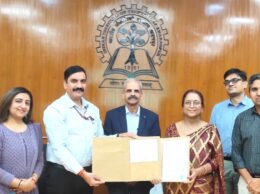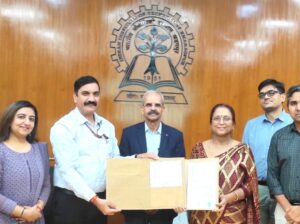West Bengal, India: Researchers from IIT Kharagpur conducted an analysis of the rural air quality using satellite measurements of NO2 in India. Prof. Jayanarayanan Kuttippurath and Research Scholar Ms. Mansi Pathak of Centre for Ocean, River, Atmosphere and Land Sciences (CORAL) of IIT Kharagpur analyzed the significant impact of urban pollution on the air quality of rural India by differentiating and assessing the depth of air pollution in rural India in the study titled “Air Quality Trends in Rural India: Analysis of NO2 Pollution using Satellite Measurements”. The analysis carefully delineates the rural and urban regions of India, to examine the unheeded rural air pollution. Most air pollution assessments till date, discussed only the urban air quality issues. This analysis exposes increasing trends (0.05–0.44×1015molec./cm2/yr) of NO2 in the rural regions of India.
Rural sources account for 41% of the overall NO2 pollution in India of which 45% and 40% are from transportation and power sectors, respectively. As the sources of NO2 are well coupled to the industrial and economic upliftment of a nation, the analyses for the rural regions show distinct seasonal changes with the highest value (2.0 × 1015 molecules per cm2) in winter and the lowest in monsoon (1.5 × 1015 molecules per cm2) seasons. This study (https://doi.org/10.1039/D2EM00293K) suggests the need for taking action towards improving rural air quality to reduce the impact of air pollution on the large rural population of India. Although NO2 is a non-abundant gas, its indirect impact on global climate change is likely to be greater, with a net cooling effect attributed to the oxidation-fueled aerosol production. NOx levels in the troposphere can alter ozone formation, contribute to nitrate aerosol formation, and acid deposition and affect regional climate.
“What we observe is that there is a decline in air quality in rural India in terms of our NO2 analysis, which is not beyond the threshold levels now, except in regions such as Delhi and suburbs, lower IGP and eastern India. However, given the positive trend in NO2 concentration, the high rate of urbanization and relocation of industries to suburbs, growing population and development activities, other regions of India would also cross the pollution threshold to impact the health of its people, and thus, our massive rural population. This is the real concern and it is the right time to take appropriate actions to control the atmospheric pollution in rural India,” suggested Prof. Jayanarayanan Kuttippurath, CORAL, IIT Kharagpur and lead researcher of the study.
Air pollution is one of the biggest problems in India’s major cities. Comparison of pollutant-wise highest health risk values show that NO2 is about 19 times more harmful than Particulate Matter (PM) and about 25 times more risky than that of SO2. The population residing in the regions of high NO2 such as in the proximity of power plants, industries, cities, and in the areas above the permissible limit, are prone to be at high risk of adverse health effects such as asthma, bronchitis, pneumonia and cardiovascular diseases.
“We usually think the atmospheric pollution exists only in cities or it is just an urban threat. The air quality standards in rural regions are often neglected. However, our analysis suggests that it is high time to shift our focus to rural regions and examine the pollution levels and health issues of rural India. This is of paramount importance for a country like India, as rural areas have about 67% of the country’s population (947 million) as of 2020 and public health today stands out to be the utmost priority globally,” said Ms. Mansi Pathak, Research Scholar, IIT Kharagpur & lead author of the paper.
Although, other Indian rural regions are under permissible limits of CPCB, the increasing trends in NO2 would surpass the standards in future if no controlling measures are implemented, which is a serious concern. Regulations similar to the Bharat Stage norms (for limiting vehicular emissions) need to be implemented in thermal power plants and industries located in both rural and urban regions, to restrict the overall NOx pollution in rural India. Introducing new natural gas-fed power plants or using selective catalytic reduction (SCR) in older power plants can also reduce emissions, and thus, the NO2 pollution in rural India.









